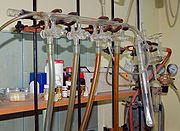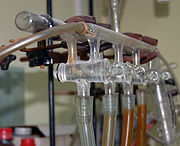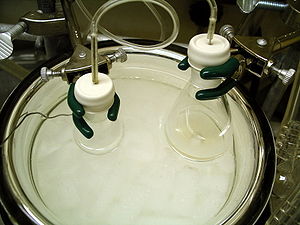
Schlenk line
Encyclopedia


The Schlenk line is a commonly used chemistry
Chemistry
Chemistry is the science of matter, especially its chemical reactions, but also its composition, structure and properties. Chemistry is concerned with atoms and their interactions with other atoms, and particularly with the properties of chemical bonds....
apparatus developed by Wilhelm Schlenk
Wilhelm Schlenk
Wilhelm Johann Schlenk was a German chemist. He was born in Munich and also studied chemistry there. Schlenk succeeded Hermann Emil Fischer at the University of Berlin in 1919....
. It consists of a dual manifold with several ports. One manifold is connected to a source of purified inert gas
Inert gas
An inert gas is a non-reactive gas used during chemical synthesis, chemical analysis, or preservation of reactive materials. Inert gases are selected for specific settings for which they are functionally inert since the cost of the gas and the cost of purifying the gas are usually a consideration...
, while the other is connected to a high-vacuum pump
Vacuum pump
A vacuum pump is a device that removes gas molecules from a sealed volume in order to leave behind a partial vacuum. The first vacuum pump was invented in 1650 by Otto von Guericke.- Types :Pumps can be broadly categorized according to three techniques:...
. The inert gas line is vented through an oil bubbler
Oil bubbler
An gas bubbler is a piece of laboratory glassware which consists of a glass bulb filled with a small amount of fluid — usually mineral or silicone oil, less commonly mercury. The inlet to the bulb is connected to a ground glass joint, while the outlet is vented to the air.Gas bubblers are...
, while solvent vapors and gaseous reaction products are prevented from contaminating the vacuum pump through a liquid nitrogen
Liquid nitrogen
Liquid nitrogen is nitrogen in a liquid state at a very low temperature. It is produced industrially by fractional distillation of liquid air. Liquid nitrogen is a colourless clear liquid with density of 0.807 g/mL at its boiling point and a dielectric constant of 1.4...
or dry ice
Dry ice
Dry ice, sometimes referred to as "Cardice" or as "card ice" , is the solid form of carbon dioxide. It is used primarily as a cooling agent. Its advantages include lower temperature than that of water ice and not leaving any residue...
/acetone
Acetone
Acetone is the organic compound with the formula 2CO, a colorless, mobile, flammable liquid, the simplest example of the ketones.Acetone is miscible with water and serves as an important solvent in its own right, typically as the solvent of choice for cleaning purposes in the laboratory...
cold trap
Cold trap
In vacuum applications, a cold trap is a device that condenses all vapors except the permanent gases into a liquid or solid. The most common objective is to prevent vapors from a vacuum pump from contaminating the experiment or sample of interest. Cold traps also refer to the application of cooled...
. Special stopcock
Stopcock
A stopcock is a valve used to restrict or isolate the flow of a liquid or gas through a pipe.In Great Britain a stopcock, not to be confused with a gate valve or a DiCiaccio branch, is used to prevent flow of water into a domestic water system. There are usually two stopcocks for a home...
s or Teflon taps allow for vacuum or inert gas to be selected without the need for placing the sample on a separate line.
Schlenk lines are useful for safely and successfully manipulating air sensitive
Air sensitive
Air sensitivity is a term used, in particular in chemistry, to denote the reactivity of chemical compounds with some constituent of air. Most often, reactions occur with atmospheric oxygen or water vapor , although reactions with the other constituents of air such as carbon monoxide , carbon...
compounds. The high vacuum
Vacuum
In everyday usage, vacuum is a volume of space that is essentially empty of matter, such that its gaseous pressure is much less than atmospheric pressure. The word comes from the Latin term for "empty". A perfect vacuum would be one with no particles in it at all, which is impossible to achieve in...
is also often used to remove the last traces of solvent
Solvent
A solvent is a liquid, solid, or gas that dissolves another solid, liquid, or gaseous solute, resulting in a solution that is soluble in a certain volume of solvent at a specified temperature...
from a sample. Vacuum gas manifolds often have many ports and lines, and with care it is possible for several reactions
Chemical reaction
A chemical reaction is a process that leads to the transformation of one set of chemical substances to another. Chemical reactions can be either spontaneous, requiring no input of energy, or non-spontaneous, typically following the input of some type of energy, such as heat, light or electricity...
or operations to be run simultaneously.
When the reagents are highly susceptible to oxidation, traces of oxygen may pose a problem. Then, for the removal of oxygen below the ppm level, the inert gas needs to be purified by passing it through a deoxygenation catalyst. This is usually a column of copper(I) or manganese(II) oxide which reacts with oxygen traces present in the inert gas.
Techniques
The main techniques associated with the use of a Schlenk line include:- counterflow additions, where air-stable reagentReagentA reagent is a "substance or compound that is added to a system in order to bring about a chemical reaction, or added to see if a reaction occurs." Although the terms reactant and reagent are often used interchangeably, a reactant is less specifically a "substance that is consumed in the course of...
s are added to the reaction vessel against a flow of inert gas. - the use of syringes and rubber septa to transfer liquids and solutions
- cannula transferCannula transferCannula transfer or cannulation is a subset of air-free techniques used with a Schlenk line, in transferring liquid or solution samples between reaction vessels via cannulae, avoiding atmospheric contamination. While the syringes are not the same as cannulae, the techniques remain relevant.There...
, where liquids or solutions of air-sensitive reagents are transferred between different vessels stoppered with septa using a long thin tube known as a cannula. Liquid flow is achieved via vacuum or inert gas pressure.
Glassware are usually connected via tightly fitting and greased ground glass joint
Ground glass joint
Ground glass joints are used in laboratories to quickly and easily fit leak-tight apparatus together from commonly available parts. For example, a round bottom flask, Liebig condenser, and oil bubbler with ground glass joints may be rapidly fitted together to reflux a reaction mixture...
s. Round bends of glass tubing with ground glass joints may be used to adjust the orientation of various vessels.
Filtration under inert conditions poses a special challenge that is usually tackled with specialized glassware. A Schlenk filter consists of sintered glass funnel fitted with joints and stopcocks. By fitting the pre-dried funnel and receiving flask to the reaction flask against a flow of nitrogen, carefully inverting the set-up, and turning on the vacuum appropriately, the filtration may be accomplished with minimal exposure to air.
Dangers
The main dangers associated with the use of a Schlenk line are the risks of an implosion or explosionExplosion
An explosion is a rapid increase in volume and release of energy in an extreme manner, usually with the generation of high temperatures and the release of gases. An explosion creates a shock wave. If the shock wave is a supersonic detonation, then the source of the blast is called a "high explosive"...
. An implosion can occur due to the use of a high vacuum and flaws in the glass apparatus.
An explosion can occur due to the common use of liquid nitrogen
Nitrogen
Nitrogen is a chemical element that has the symbol N, atomic number of 7 and atomic mass 14.00674 u. Elemental nitrogen is a colorless, odorless, tasteless, and mostly inert diatomic gas at standard conditions, constituting 78.08% by volume of Earth's atmosphere...
in the cold trap
Cold trap
In vacuum applications, a cold trap is a device that condenses all vapors except the permanent gases into a liquid or solid. The most common objective is to prevent vapors from a vacuum pump from contaminating the experiment or sample of interest. Cold traps also refer to the application of cooled...
, used to protect the vacuum pump from solvents. If a reasonable amount of air is allowed to enter the Schlenk line, liquid oxygen
Oxygen
Oxygen is the element with atomic number 8 and represented by the symbol O. Its name derives from the Greek roots ὀξύς and -γενής , because at the time of naming, it was mistakenly thought that all acids required oxygen in their composition...
can condense into the cold trap as a pale blue liquid. An explosion may occur due to reaction
Chemical reaction
A chemical reaction is a process that leads to the transformation of one set of chemical substances to another. Chemical reactions can be either spontaneous, requiring no input of energy, or non-spontaneous, typically following the input of some type of energy, such as heat, light or electricity...
of the liquid oxygen with any organic compounds also in the trap.
See also
- Air-free techniqueAir-free techniqueAir-free techniques refer to a range of manipulations in the chemistry laboratory for the handling of compounds that are air-sensitive. These techniques prevent the compounds from reacting with components of air, usually water and oxygen; less commonly carbon dioxide and nitrogen...
gives a broad overview of methods including- GloveboxGloveboxA glovebox is a sealed container that is designed to allow one to manipulate objects where a separate atmosphere is desired. Built into the sides of the glovebox are gloves arranged in such a way that the user can place their hands into the gloves and perform tasks inside the box without breaking...
- used to manipulate air-sensitive (oxygen- or moisture-sensitive) chemicals. - Schlenk flaskSchlenk flaskA Schlenk flask, or Schlenk tube is a reaction vessel typically used in air sensitive chemistry, invented by Wilhelm Schlenk. It has a side arm fitted with a PTFE or ground glass stopcock which allows the vessel to be evacuated or filled with gases...
- reaction vessel for handling air-sensitive compounds. - Perkin trianglePerkin triangleA Perkin triangle is a specialized apparatus for the distillation of air-sensitive materials. It is named after William Henry Perkin Jr., whose design was approximately triangular in shape. The image opposite shows a more modern version in which the glass taps have been replaced with more air-tight...
- used for the distillation of air-sensitive compounds.
- Glovebox

